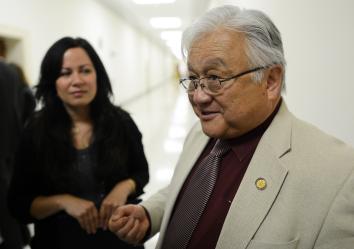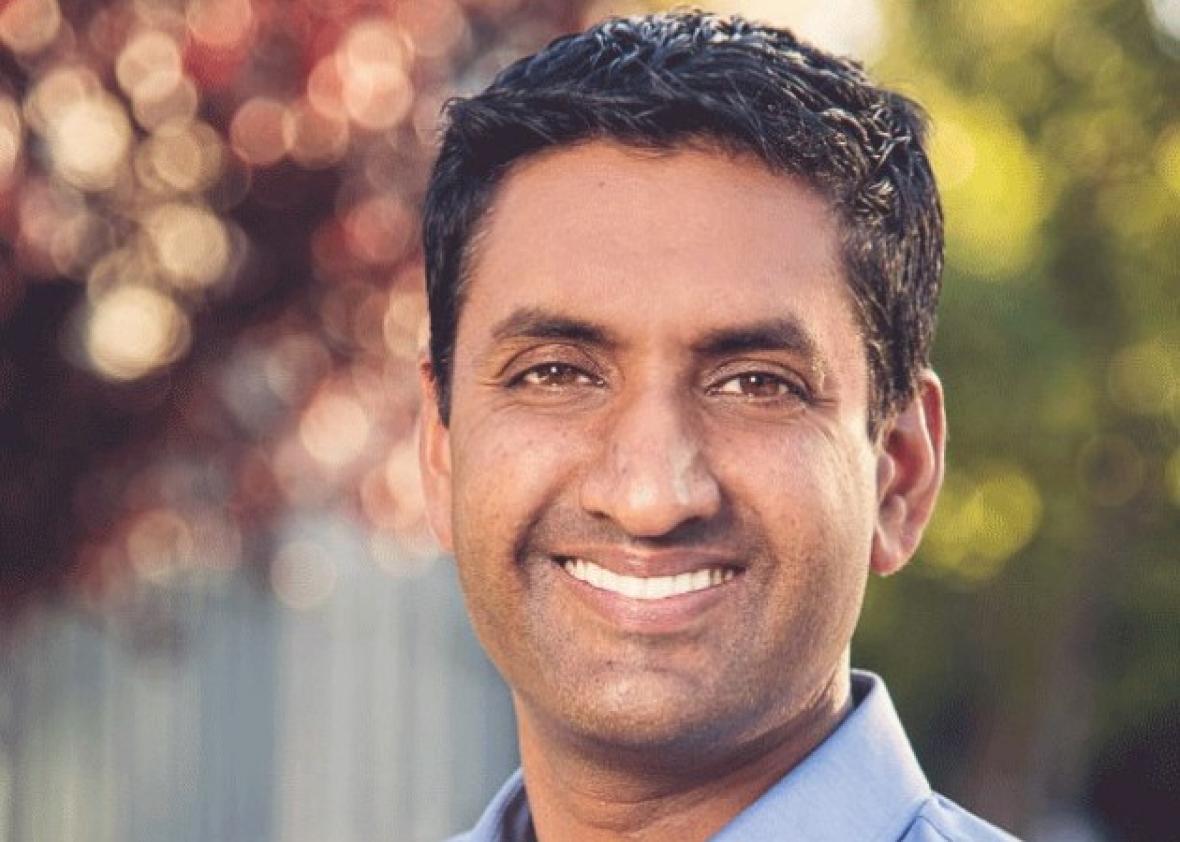When you think about Silicon Valley’s influence on national politics, you might think of Mark Zuckerberg’s immigration initiative, Peter Thiel’s support for Donald Trump, or the high-tech presidential campaigns of Barack Obama and Hillary Clinton. Often overshadowed on the national stage are the region’s actual representatives in Congress.
They aren’t exactly the starry-eyed young techies you might expect. Anna Eshoo, 73, D-Menlo Park; Zoe Lofgren, 68, D-San Jose; and Jackie Speier, 66, D-Hillsborough, are all longtime politicians who have gradually worked their way up from the local level. Nancy Pelosi, 76, D-San Francisco, is a powerful force in Democratic politics, but technology has never been her chief focus, and there’s perennial debate as to whether her district counts as Silicon Valley. Then there is Mike Honda, 75, D-Silicon Valley, who spent some 25 years in local politics and another five at the state level before his election to Congress, where he has served since 2001.
Each of them has proven able in various ways, and they’ve all been popular enough to hold their seats for multiple terms. Lofgren, in particular, has demonstrated tech savvy and an interest in the internet, helping to lead the charge against SOPA and authoring Aaron’s Law, named in honor of the late hacker Aaron Swartz. (She even wrote for Future Tense in October, arguing that changing votes isn’t the only way hackers could wreak Election Day chaos.) Yet if you were looking for a representative who embodied the go-go Silicon Valley zeitgeist, or whose support was rooted in the region’s technology industry, you wouldn’t find it among this delegation.
That may be about to change.
Honda, whose district stretches from the Tesla Motors factory in Fremont to Apple’s headquarters in Cupertino—taking in Intel, Yahoo, and eBay along the way—is in danger of losing his seat to a fellow Democrat who is 35 years younger. Khanna, whose campaigns have boasted the support from an ever-growing cadre of tech leaders, came within a few points of unseating him in 2014. This year, he edged Honda in the open primary, and the two are about to square off again in Tuesday’s general election. Polls have shown them neck-and-neck, with some giving Khanna a narrow lead.

Jewel Samad/AFP/GettyImages
Khanna, who recently turned 40, is not actually a technologist. He’s a Yale Law graduate who served briefly in the Obama administration (as deputy assistant secretary of the Commerce Department), worked for the prominent tech law firm Wilson Sonsini, lectures on economics at Stanford University, and wrote a book about the future of American manufacturing. Nonetheless, he has managed to style himself as a Silicon Valley candidate thanks to his youthful zeal, his close ties with the tech industry, and a policy platform that centers on “21st-century” education and job creation.
There’s also something distinctly startup-y about his political career. Rejecting the convention of paying one’s dues at the local level, he first ran for U.S. Congress at the age of 27 and has refused to aim any lower in the time since. Fail fast, as the saying goes.
Khanna’s supporters include a laundry list of tech magnates such as investor Marc Andreessen, Yahoo’s Marissa Mayer, Salesforce’s Marc Benioff, Facebook’s Sheryl Sandberg, and even investor and entrepreneur Keith Rabois, Thiel’s longtime friend and fellow conservative rabble-rouser. But what’s really interesting about his 2016 campaign, from an outsider’s perspective, is how little it has emphasized these tech industry associations.
In 2014, Khanna seemed to embrace the “tech candidate” mantle, drawing national attention that included profiles in the New York Times and the New Yorker. But not all of the attention was positive: The Nation derided him as a “tech groupie,” and tech blog Pando Daily called him “Silicon Valley’s Own(ed) Man.” More importantly, his talk of “disruption” and “innovation” seemed to impress outsiders more than it did local voters. They turned out to back the incumbent who had long-established relationships with the local trade unions, progressive advocacy groups, and Democratic power players.
Khanna’s second run at Honda has attracted far less hype in the national media, and that may be by design. Look at the list of endorsements on his campaign website, and you’ll have to scroll to the very bottom to find the “technology leaders.” Top billing goes instead to local newspapers, Democratic politicians, and labor unions. And Khanna rarely brings up his tech ties at campaign events, where he is careful to portray himself as someone who’s as thoughtful about the drawbacks of the high-tech economy as he is about its potential benefits.
In a recent interview with public television station KQED, Khanna focused on the challenges that automation will present for employment and the changes in both educational curricula and the social safety net that will be needed to meet them. Specifically, he endorsed a greater role for technical education, Robert Reich’s plan for free college tuition, and the idea (popular in Silicon Valley) of a universal basic income. He also seems to have put a lot more legwork into winning the support—or at least heading off the opposition—of the Democratic establishment, which often looks askance at same-party bids to unseat an incumbent.
If anything, it’s been Honda who has tried to tie Khanna to unpopular tech figures this time around. Honda’s campaign publicized Thiel’s donations to Khanna as a sign that Khanna might secretly harbor some affinity for Trump. In a controversial attack ad, Honda’s campaign hired a South Asian actor to play Khanna as a blinged-out businessman in a tailored suit, taking a call from “Wall Street” on his cellphone. (The ad, which seemed to play on racial stereotypes, was especially jarring coming from the campaign of a man who survived a Japanese internment camp. Honda’s district, by the way, is the only one outside of Hawaii in which Asian Americans compose a majority of the electorate.)
Honda’s tactics, ham-handed as they’ve been, highlight an interesting political dynamic. Khanna’s self-presentation as an innovative, forward-thinking candidate clearly holds appeal with a significant number of voters. And he has continued to portray Honda as ineffectual and out of touch—“low-energy,” Trump might say—an angle that has gained momentum thanks to a probe of Honda by the House Ethics Committee. At the same time, both campaigns seem to have agreed that there’s a danger in aligning oneself too cozily with big technology, even in the heart of Silicon Valley.
After a string of defeats, Khanna appears to have finally absorbed this lesson. Politically, he has evolved from the 28-year-old who brashly challenged the late liberal foreign-policy lion Tom Lantos in a 2004 Democratic primary. (Khanna got squashed.) He now tries to present himself as a sort of community organizer, active in local volunteerism and pro bono legal work. “Losing forces you to look at where you were weak and where you could have done better,” Khanna told the San Francisco Chronicle in May. “This time I’ve focused on local issues, like soccer parks in Santa Clara or odor problems in Milpitas.”
Still, there are flashes of what critics see as a sense of entitlement. Among a recent batch of WikiLeaks emails was a June 2015 thread between Khanna’s campaign chair* Steve Spinner and Clinton campaign chair John Podesta, in which Spinner whined about Honda’s tactics. While the rhetoric focused on fairness and the good of the Democratic party, the unsubtle message was that Khanna had powerful Silicon Valley supporters whom Clinton would do well not to offend. Spinner wrote: “John, every time Honda attacks Ro’s tech and south asian supporters it has a dampening effect on fundraising for Hillary and other Dem candidates.”
If Khanna wins on Tuesday, it will be tempting to view him as a bellwether for the future of Silicon Valley politics. It might seem to portend a new era in which the likes of Andreessen, Sandberg, and Rabois form a sort of bipartisan king-making committee for tech-friendly candidates. But the particulars of this race argue for a less sweeping interpretation. If Khanna prevails, it will prove that one can win in Silicon Valley as a “tech candidate,” but only if a lot else goes right. In this case, it will have taken Khanna three tries over the course of 12 years, a wide fundraising advantage, some local ring-kissing, and a weakening incumbent under the cloud of an ethics probe. Eshoo, Lofgren, and Speier can probably rest easy.
Update, Nov. 2, 2016: This post has been edited to remove a duplicate paragraph.
*Correction, Nov. 3, 2016: This post originally referred to Steve Spinner as Khanna’s ex-campaign chair. He is Khanna’s current campaign chair.
